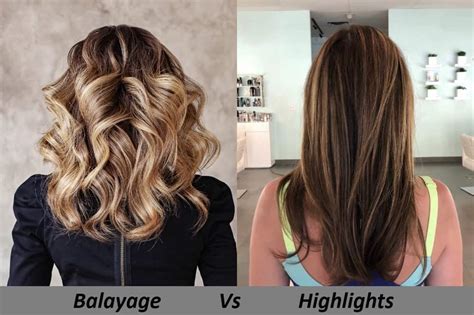Introduction
Balayage and highlights are two popular hair coloring techniques that can transform your look. However, there are key differences between the two that you should know before making a decision. In this article, we’ll compare balayage vs highlights based on various factors, including application, maintenance, cost, and overall results.

1. Application: Freehand vs Foils
-
Balayage: Balayage is a freehand technique where color is painted onto the hair using a brush. This creates a more natural, blended look with soft, subtle transitions.
-
Highlights: Highlights are created using foils or caps. Hair is separated into sections, and the lightener is applied to specific strands. This produces a more defined, contrasting result.
2. Maintenance: Less Fading vs More Frequent Touch-Ups
-
Balayage: Balayage requires less frequent touch-ups than highlights because the color is blended into the hair. As your hair grows, the roots will be less noticeable.
-
Highlights: Highlights require more frequent touch-ups to maintain the contrast between the colored and uncolored sections.
3. Cost: Varies Based on Technique and Salon
-
Balayage: Generally, balayage is more expensive than highlights because it requires more time and skill to apply.
-
Highlights: Highlights can vary in cost depending on the technique used (e.g., foil vs cap) and the number of sections colored.
4. Results: Natural vs Bold
-
Balayage: Balayage creates a more natural, sun-kissed look. It’s ideal for enhancing your hair’s natural color and adding subtle dimension.
-
Highlights: Highlights produce a bolder, more defined look. They can dramatically change the color of your hair and add contrast.
5. Hair Health: Less Damage vs More Processing
-
Balayage: Balayage is less damaging to hair than highlights because the color is not applied to the entire head.
-
Highlights: Highlights require more bleach, which can damage hair if not applied properly.
6. Versatility: Suits All Hair Types vs Better for Fine Hair
-
Balayage: Balayage suits all hair types, including thick, thin, straight, and curly hair.
-
Highlights: Highlights are particularly suitable for fine hair because they can add volume and texture.
7. Color Options: Unlimited vs Limited
-
Balayage: Balayage offers unlimited color options, allowing you to create customized hair colors that complement your skin tone and personal style.
-
Highlights: Highlights are typically limited to lighter shades than the natural hair color.
8. Time Commitment: Longer vs Shorter Appointment
-
Balayage: Balayage appointments typically take longer than highlights, as the color is applied freehand and requires more blending.
-
Highlights: Highlights can be applied more quickly, especially if foils are used.
9. Trend Factor: Timeless vs Current
-
Balayage: Balayage is a timeless technique that has been popular for decades. It continues to be a go-to choice for natural-looking hair color.
-
Highlights: Highlights are more trendy and can vary in popularity depending on the season and fashion trends.
10. Customer Preferences: Based on Individual Needs
Ultimately, the best hair coloring technique for you depends on your individual preferences and hair goals. Consider the following factors when making your decision:
- Desired look: Natural vs bold
- Hair health: Less damage vs more processing
- Maintenance: Frequent touch-ups vs infrequent
- Cost: Budget-friendly vs premium
- Time commitment: Long vs short appointments
Tables for Comparison
Table 1: Key Differences at a Glance
| Feature | Balayage | Highlights |
|---|---|---|
| Application | Freehand | Foils or caps |
| Maintenance | Less frequent | More frequent |
| Cost | More expensive | Varies |
| Results | Natural | Defined |
| Hair health | Less damaging | More damaging |
| Versatility | All hair types | Fine hair |
| Color options | Unlimited | Limited |
| Time commitment | Longer | Shorter |
| Trend factor | Timeless | Trendy |
| Customer preferences | Individual needs | Individual needs |
Table 2: Application and Technique
| Feature | Balayage | Highlights |
|---|---|---|
| Color application | Painted onto hair | Applied to specific strands |
| Foils / caps | Not used | Used |
| Precision | Less precise | More precise |
| Blending | More blended | Less blended |
Table 3: Maintenance and Touch-Ups
| Feature | Balayage | Highlights |
|---|---|---|
| Root growth | Less noticeable | More noticeable |
| Touch-up frequency | Infrequent (every 4-6 months) | Frequent (every 6-8 weeks) |
| Color fading | Gradual | Sharper |
Table 4: Cost and Value
| Feature | Balayage | Highlights |
|---|---|---|
| Average cost | $150-$300 | $100-$200 |
| Value for money | More for less maintenance | Less for more touch-ups |
| Price factors | Salon, stylist, hair length | Salon, stylist, number of foils |
Conclusion
Balayage and highlights are both excellent hair coloring techniques that can enhance your look. The best choice for you depends on your individual preferences and hair goals. By understanding the key differences between the two, you can make an informed decision that will give you the hair you’ve always wanted.
